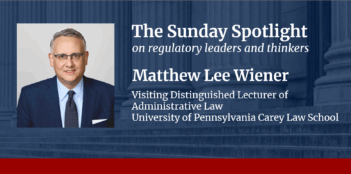
Learn about the history of regulatory capture, its effect on public policy, and remedies for addressing corruption.
It’s a rallying cry heard on both sides of the aisle: government is the puppet of special interest groups. Allegations often concern Big Money’s control over Congress, yet federal agencies also are accused of falling victim to special interest influence. The control that industries exert over the federal regulatory bodies meant to regulate them is called “regulatory capture.” Recently, the Administrative Conference of the United States, a federal agency dedicated to improving the administrative process, held a forum exploring the issue.
The Regulatory Review has compiled the following set of resources for learning about the history of regulatory capture, its effects on public policy, and remedies to corruption.
Books:
- Regulation and Public Interests: The Possibility of Good Regulatory Government by Steven P. Croley (2007)
- Preventing Regulatory Capture: Special Interest Influence and How to Limit It edited by Daniel Carpenter and David Moss (2013)
- Too Big to Jail: How Prosecutors Compromise with Corporations by Brandon L. Garrett (2014)
- Reckless Endangerment: How Outsized Ambition, Greed, and Corruption Led to Economic Armageddon by Gretchen Morgenson and Joshua Rosner (2012)
Background Academic Papers:
- The Theory of Economic Regulation by George J. Stigler (1971) (setting forth the traditional theory of regulatory capture)
- Regulatory Capture, Public Interest, and the Public Agenda: Toward a Synthesis by Michael E. Levine and Jennifer L. Forrence (1990) (theorizing regulatory capture)
- Regulating Capture: A Review by Ernesto Dal Bo (2006) (reviewing empirical and theoretical literature on regulatory capture)
- The Complexity of Regulatory Capture: Diagnosis, Causality and Remediation by Sidney Shapiro (2011) (defining, explaining, and providing remedies for regulatory capture)
- A Revisionist History of Regulatory Capture by William J. Novak (2013) (also available in Preventing Regulatory Capture: Special Interest Influence and How to Limit it edited by Daniel Carpenter and David Moss) (providing a critical look at the emergence of regulatory capture in the United States)
- Corralling Capture by David Freeman Engstrom (2013) (calling for more rigor in how we define and frame the issue of regulatory capture)
- Enlightened Regulatory Capture by David Thaw (2014) (exploring how regulatory capture can help regulators more effectively capitalize on private expertise to pursue public goals)
- Capturing Regulatory Reality: Stigler’s The Theory of Economic Regulation by Christopher Carrigan & Cary Coglianese (2016) (providing a retrospective assessment of George Stigler’s classic article, specifically assessing both its shortcomings as well as its enduring value)
Financial Regulation:
- “Capture” in Financial Regulation: Can We Channel it Toward the Common Good? (2011) by Lawrence G. Baxter (exploring the concept of regulatory capture in financial regulation)
- Understanding Regulatory Capture: An Academic Perspective from the United States by Lawrence G. Baxter (2012) (exploring regulatory capture in financial regulation)
- “Virtuous Capture” by Matthew Wansley (argues in favor of the virtues of certain forms of regulatory capture)
- Testimony of Robert Hockett before the U.S .Senate Committee on Banking, Housing and Urban Affairs, Improving Financial Institution Supervision: Examining and Addressing Regulatory Capture (2012) (making recommendations based on how regulatory capture might be at work at the Fed and other agencies)
Telecommunications:
- Of Blogs, eBooks, and Broadband: Access to Digital Media as a First Amendment Right by Hannibal Travis (2007) (exploring the concept of “corporate socialism” in the context of the media industry’s “control” over the Federal Communications Commission)
- F.C.C. Commissioner Leaving to Join Comcast by Edward Wyatt (2011) (exploring the possible “complete capture of government” through a “continuously revolving door at the FCC”).
International Perspectives:
- In and Out of the Revolving Door: Making Sense of Regulatory Capture by Toni Makkai and John Braithwaite (1992) (arguing that regulatory capture is a “situation problem that requires situational results)
- Regulatory Capture in Banking by Daniel C. Hardy (2006) (exploring whether “regulatory capture” in banking effects the quality of regulation)
- Regulatory Capture Revisited—Lessons from Economies of Corruption by Frederic Boehm (2007) (identifies “weak points” of regulation and recommends new “anti-capture policy measures”)
- Striking at the Root Problem of Canadian Environmental Law: Identifying and Escaping Regulatory Capture by Jason MacLean (2016) (arguing that regulatory capture is “the systemic problem underlying Canadian environmental law and policy”)
Additional Articles and Op-Eds:
- Regulatory Capture 101 (2014) (criticizing the media’s coverage of regulatory capture)
- The Morning Risk Report: Is ‘Regulatory Capture’ a Myth? by Joel Schectman (2015) (exploring to what extent regulatory capture actually occurs)
- One Way to Rebuild Our Institutions by Elizabeth Warren (2016)
- A Revolving Door Helps Big Banks’ Quit Campaign to Muscle Out Fannie and Freddie by Gretchen Morgenson (2015) (on big banks and Fannie Mae and Freddie Mac)
- The Financial Crisis: Why Have No High-Level Executives Been Prosecuted? by Jed S. Rakoff (2014)
- Justice Deferred is Justice Denied by Jed S. Rakoff (2015) (review of Brandon Garrett’s book, Too Big to Jail)
Reports:
- Rigged Justice: How Weak Enforcement Lets Corporate Offenders Off Easy. January 2016. Prepared by the Office of Elizabeth Warren.
Recent Legislation:
- Regulatory Capture Prevention Act of 2011. S. 1338. Introduced by Senator Sheldon Whitehouse (D-RI) on 7/7/2011. Latest Action: 7/20/2011 – Committee on Homeland Security and Government Affairs – Hearings Held.
- Truth in Settlements Act of 2015. S. 1109. Introduced by Senator Elizabeth Warren (D-MA) on 4/28/2015. Latest Action: 6/9/2016 – placed on the Union Calendar, Calendar No. 476.
This resource list is part of The Regulatory Review‘s sixteen-part series, Rooting Out Regulatory Capture.



